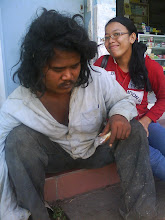Schizophrenia When some layperson hear the word schizophrenia, they immediately think of the parior room diagnosis, "split personality". It is not exactly clear what "split personality" means, perhaps something akin to a Jekyll and Hyde experience or a multiple personality disorder, but it is not a diagnostic substitute for schizophrenia. Schizophrenia is not characterized by a changing personality, it is characterized by a deteriorating personality. Therefore, this popular notion os a dramatic personality changes come far short of capturing the devastating effect schizophrenia has on the life of a person and the person's family. Simply, schizophrenia is one of the most profoundly disabling illnesses, mental or physical, the nurse will ever treat. Schizophrenia is a diagnostic term used by mental health professional to describe a group of mental disturbances that feature withdrawal, affective problems, and interrupted thought processes that typically first appear in young adulthood. The cost of schizophrenia in human suffering is incalculable. It is known that approximately 1% of the population will experience schizophrenia during their lifetime, and that it affects both sexes equally. Furthermore, the prevalence rate and symptom presentation for schizophrenia are constant worldwide. Inner-city residents and those from lower socioeconomic classes, however, are disproportionately affected and/or diagnosed. Bleulers's four As: Criteria for Schizophrenia Etiology Many authorities suggest that multiple factors must cause schizophrenia, because no single theory cause schizophrenia explains the disorder. -- Predisposing factors to schizophrenia -- Biological Theories Biological theories posit that schizophrenia is caused by anatomical or physiological abnormalities. Biological explanations include biochemical, neurostructural, and genetic theories. Biological explanations have driven the development of biological interventions, such as psychotropic drugs and somatic therapies. Some clinicians have been reluctant to endorse biological theories. The reasons are varied, but a common denominator is that biological theories deemphasize the psychosocial approach, which these clinicians favor. The exclusive use of biological approaches, such as psychotropic and somatic therapies, excludes the interpersonal factor. The psuchotherapeutic management model, however, recognizes the importance of both biological and interpersonal interventions. A positive result of biological theories has been the minimization of the "blaming" that is inherent in other explanations. Just as viewing alcoholism as an illness has helped clinicians, families, and patients to get beyond blaming and on the treatment, biological theories have facilitated the treatment of schizophrenia. To illustrate, just at diabetic or cardiac patients must learn to cope with the limitations of their illness. The prevailing biochemical process explanation is referred to as the dopamine hypothesis. According to this hypothesis, excessive dopaminergic activity in cortical areas causes acute positive symptoms os schizophrenia (hallucinations, delucions, and thought disorder). Excessive dopamine could be a result of increased dopamine synthesis, increase dopamine release or turnover, or an increase in the number and activity of dopamine receptors (Brown and Mann, 1985). It is known also that drugs that drugs that increase dopamine, such as the antiparkinson drugs L-dopaa, can cause a psychotic state. Other biochemical explanations are not as convincing as the dopamine hypothesis. Elevated norepinephrine levels, lowered homovanilic acid level, and the activity of various neuromodulators (including opioid peptides, gamma-aminobutyric acid (GABA), prostaglandins, acetylcholine, and histamine) have been implicated in the development of schizophrenia. Research efforts have not consistently linked these altered biochemical states with schizophrenia. The neurostructural theorist propose that schizophrenia, particularly negative schizophrenia, is a result of pathoanatomy. The three specific neurostructural changes mentioned most often are increased VBRs, brains atrophy, and decreased CBF. Persons with schizophrenia seem to inherit a predispositions to the disorder. Their relatives have a greater incidences of schizophrenia than chance alone would allow. Genetic Risk for Schizophrenia Identical twin affected Both parents affected Fraternal twin affected One parent affected Brother or sister affected Second-degree relative affected No affected relative 50% 35% 15% 15% 10% 2-3% 1% Some researchers believe that schizophrenia can be linked to the season of birth and consequent large flu epidemics. The research in this area is far from conclusive, but there is evidence that individuals with schizophrenia are more likely to have been born in the winter months. Other researchers suggest a high incidence of birth trauma and injury among persons with schizophrenia. Again, studies in this area are far for establishing a relationship between schizophrenia and birth problems. In addition to the foregoing, a number of neurological abnormalities, such as motor coordination (e.g. balance, hopping, and finger thumb opposition), are found among persons with schizophrenia. Eye tracking abnormalities are thought to be a distinguishing biological feature as well. References: Antai Deborah and Otong. 1995. Psychiatric nursing biological and behavioral concepts. USA: WB.Saunders Company Kaplan, Harold I and Benjamin J. Sadock. 1995. Comprehensive textbook of psychiatry volume 1 sixth edition. USA: Williams & Wilkins Stuart, Wiscarz and Sandra J. Sundeen. 1991. Principles and Practice of Psychiatric Nursing fifth edition. USA: Von Hoffman Press Inc Videback, Sheila L. 2004. Psychiatric Mental Health Nursing second edition. Philadelphia: Lippincott Williams & Wilkins Worret, Fortinash Holoday. 2007. Psychiatric Nursing Care Plans fifth edition. USA: Westline Industry Drive Yosep, Iyus. 2009. Keperawatan Jiwa edisi revisi. Bandung: PT Refika Aditama
Rabu, 02 Desember 2009
Predisposing factors to schizophrenia
Affective disturbance: inappropriate, blunted, or flattened affect
Autism: preoccupation with the self without concern for external rality
Associative looseness: the stringing together of unrelated topics
Ambivalences: simultaneous opposites feelings
Characteristic symptoms (at least two of the following):
Delusions
Hallucinations
Disorganized speech
Grossly disorganized or catatonic behavior
Negative symptoms
Social/occupational dysfunction: work, interpersonal, and self-care functioning is below the level schieved prior to onset
Duration; continuous signs of the disturbance for at least 6 months
Schizoaffective and mood disorder are not present and are not responsible for the signs and symptoms
Not cause by substance abuse or a general medical disorder
Biochemical theories
Neurostructural theories
Genetic theories
Viral infections and fetal insult
Other biological considerations
Diposting oleh irma agustina siagian di 22.29 0 komentar
Langganan:
Komentar (Atom)




